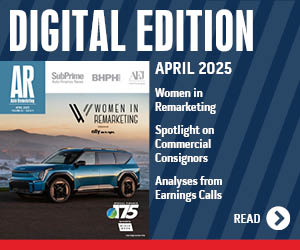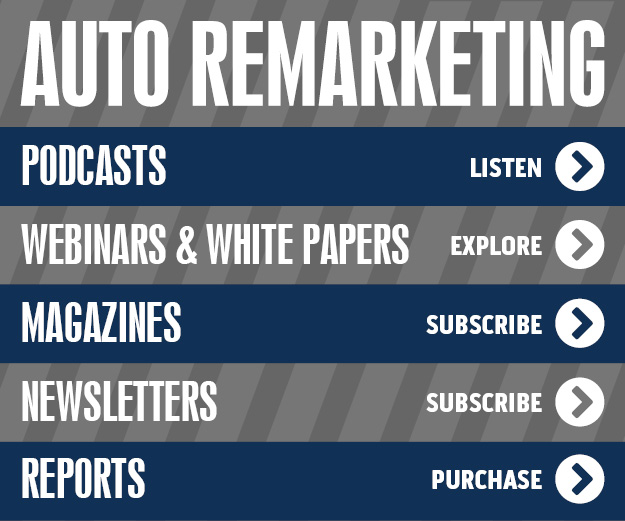Dealers Talk Technology & How It Boosts Business

In the Remarketing Technologies special section of the April 1–14 print issue of Auto Remarketing, you can see what the industry experts are saying about the role of online reputation management, mobile devices and social media within the car business.
In the same issue, we’ll also show you how a few of your fellow dealers are using these technologies to spur business and offer their best practices for getting the most out of an increasingly digitalized auto world.
Responding Effectively to Negative Reviews Online
As a dealer, maintaining a solid online reputation doesn’t necessarily mean not having a bad review on the Web.
Kraig Quisenberry is the president of Bay Auto Outlet/Wholesale Auto Direct in Port Orchard, Wash. For more than 23 years, he was the dealer partner and general manager of Bay Ford, and his experience in the car business also includes time with Subaru and Chevrolet franchises as well as within a dealer group.
He is a featured contributor for Auto Remarketing and shared some of his experiences in online reputation management.
“If you’re a dealer and don’t occasionally have a bad review or a questionable review, then either you’re amazingly perfect — which is possible — or something is awry,” said Quisenberry. “So, in my case, we monitored reviews real-time. We had Google Alerts set up — we still have it set up — to notify us of any incoming reviews and DealerRater … And if we had any review hit the site that was questionable in nature, we would instantly contact the customer and try and manage their expectations getting back on track.
“But, we were very focused on managing that in advance,” he added. “So, we were very active in the delivery aspect of just discussing CSI (with the customer), but also discussing that they would be getting a survey; what that survey would look like; how important it is to the dealership, to the salesperson, to the management staff involved and to our reputation.
“And we would, frankly, just spell out for them the fact that they could do as much damage to us as they could good; that the transaction is only one half of the business aspect of what we do. The other half is creating happy customers and satisfied customers, and not just on a temporary basis.”
As a dealer, Quisenberry felt he and his team had success “heading those (negative reviews) off the path in advance.”
But, there were the occasional negative or questionable reviews, he said. When such a review occurred, Quisenberry said he and his team took certain steps to correct the situation and help the customer.
“We would intercept those to try and get a quick turnaround, resolve (the situation) with the customer and get them to either amend or repost or delete (their negative review) and give us a good one,” he said.
And when responding to a review, Quisenberry was asked, is it better to do so in the same forum in which the negative comment or review surfaced or to respond privately? Or, should this be monitored on a case-by-case basis?
“To an extent, I think it’s case-by-case. There are certainly situations where if you worked very hard to resolve a situation, and to any means possible it was not resolvable, I think then, and only then, is it appropriate to give a response digitally to the customer’s posting,” he said.
“However, we are car dealers. And so, anything we post, no matter how well written, is going to be viewed with a degree of skepticism,” Quisenberry said. “So my first-approach opinion is that when we have a negative post, the first thing we do is, all engines stop; we pull all the information and data we have to ascertain, ‘what can we do? There has got to be something we can do to resolve this.’
“We immediately get in touch with the customer, and we monitor their posts to see how much, if any, attention it is getting,” he added. “But we do not allow posts to go more than 48 hours up without a resolve.”
And once you’re able to resolve a negative situation and turn an unsatisfied customer into a satisfied customer, there’s a chance that the shopper could end up being a social media ally for your store.
Maximizing Mobile Devices
Tilo Steurer is the founder and buyer at Eurocar, an independent dealer of high-end pre-owned luxury cars in Costa Mesa, Calif.
When asked how dealers can take advantage of the growing proclivity for mobile device usage, he emphasized that stores should be “visible to the client” in the digital world.
And for his dealership, being “visible” digitally is particularly important.
Eurocar is different than most dealerships. For starters, Eurocar specializes in pre-owned luxury and exotic vehicles, and counts Canada, Europe, Dubai and China — in addition to the U.S. — among the markets it serves.
His average piece of inventory is $100,000.
Eurocar is also located entirely inside a warehouse space with no street-front location. There’s no real drive-by or walk-in traffic; most people that come to his dealership are “serious buyers, and they find out (about the store) mostly through the Internet,” Steurer said.
“Our walk-in traffic is minimal compared to what we get on calls, eBay leads and e-mail leads in general,” he said.
As such, this underscores the importance of mobile device usage — and being visible. Steurer said it’s critical his store is easily searched and that there’s clarity in his website.
“And the most important thing, other than text, is pictures. And we’re pretty dominant when it comes to taking professional photos and making the car appear realistic; not enhanced, make it realistic. If there are flaws, they’re there. And if the car is a pristine car, it shows it.”
Eurocar includes 60 to 100 photos per car, all of which are high-quality.
“So when you’re on your mobile device, pictures say a thousand words, like we all know,” he added.
Getting the Most Out of Social Media
Within the social media realm, Ciocca Honda has an eclectic mix of activity. It uses Facebook, Twitter, YouTube, Pinterest, LinkedIn, Instagram, Google+ and (to some extent) Foursquare.
And as far as direct return of investment, Twitter might be the most effective.
“It’s easy to reach out to specific people,” said Megan Barto, the dealership’s Internet sales director. “There are many different tools and programs that you can use to find people that are in the market for a car, but Twitter is just thoughts. So you’ll see us put up (tweets) all the time, ‘Looking for a new.’ Well, right there is an opportunity for you to engage them.”
To go about engaging that particular customer, the trick is to not just throw a sales pitch out there, Barto says. When a potential customer makes such a Tweet about being in the market for a car, Barton says she’ll respond via the store’s Twitter account and ask, “Are you looking for a car, truck or SUV?”
“Now that’s not sales-y at all, it’s just conversation,” she said. “That’s the key.”
As far as Facebook, it might be the route to go to education or engage the “masses” versus just one-on-one conversation with an individual.
For instance, Ciocca Honda — which is located in Harrisburg, Pa. — recently held a Facebook contest asking consumers to weigh in on how much snow they were going get at the dealership, with a free oil change going to the winner. The dealership got dozens of comments.
“It had nothing to do with car sales. I feel the need to not force, ‘I have a new Honda here’ down people’s throats,” she said. “Because I’m a Honda dealer; if I don’t have a new Accord here on the lot, something’s wrong.”
When asked about whether or not Facebook can be used to foster greater customer loyalty and retaining the connection after the sale, Barto had this to say: “It’s all about getting the people to ‘like’ your page first. Just because they buy a car from you doesn’t mean they’re going to come and like your page. You have to have everybody in the dealership buy in.”
Barto went on to discuss ways to export email addresses into Facebook as a means to invite customers to check out your Facebook page.
“But the key is getting the people to like it,” she said. “You see the same people over and over commenting … if you pay enough attention to the likes and comments, you know who your brand advocates are.”
Editor’s Note: Staff Writer Sarah Rubenoff contributed to this story. Continue the conversation with Auto Remarketing on both LinkedIn and Twitter.


